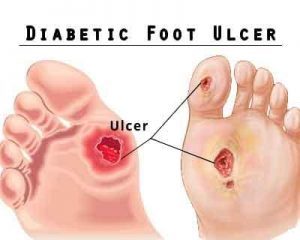- Home
- Editorial
- News
- Practice Guidelines
- Anesthesiology Guidelines
- Cancer Guidelines
- Cardiac Sciences Guidelines
- Critical Care Guidelines
- Dentistry Guidelines
- Dermatology Guidelines
- Diabetes and Endo Guidelines
- Diagnostics Guidelines
- ENT Guidelines
- Featured Practice Guidelines
- Gastroenterology Guidelines
- Geriatrics Guidelines
- Medicine Guidelines
- Nephrology Guidelines
- Neurosciences Guidelines
- Obs and Gynae Guidelines
- Ophthalmology Guidelines
- Orthopaedics Guidelines
- Paediatrics Guidelines
- Psychiatry Guidelines
- Pulmonology Guidelines
- Radiology Guidelines
- Surgery Guidelines
- Urology Guidelines
No Association Between HbA1c and Wound Outcomes of diabetic foot ulcers

According to a new study published in the journal Diabetes Care, there does not appear to be a clinically meaningful association between baseline or prospective hemoglobin A1c (A1C) and wound healing in patients with diabetic foot ulcers (DFUs).
The study was conducted by Betiel K. Fesseha, researcher at Johns Hopkins University in Baltimore, and associates, for evaluating the association between A1C and wound outcomes in patients with DFUs.
Wound healing is an innate mechanism of action that works reliably most of the time. But in certain disorders or diseases, this process is disrupted. And, one such disease is diabetes mellitus, in which the normal steps of wound healing requiring repair of the skin's extracellular matrix (ECM), is impeded. Diabetic foot ulcer develops as a result of neuropathic (nerve) and vascular (blood vessel) complications of diabetes mellitus.
Hemoglobin A1c is a form of hemoglobin that is bound to glucose. Blood test for HbA1c level is routinely performed in patients of diabetic mellitus for management of their blood glucose levels in the body.
The research was carried out by conducting a retrospective analysis of an ongoing prospective, clinic-based study of patients with DFUs treated at an academic institution during a 4.7-year period. The analysis consisted of data from 270 participants and 584 wounds. Cox proportional hazards regression was used for the assessment of the incidence of wound healing at any follow-up time in relation to categories of baseline A1C and the incidence of long-term (≥90 days) wound healing in relation to tertiles of nadir A1C change and mean A1C change from baseline, adjusted for potential confounders.
Based on the study, the researchers found out that baseline A1C was not associated with wound healing in univariate or in fully adjusted models. In the participants with baseline A1C <7.5 percent (hazard ratio [HR], 2.07; 95 percent CI, 1.08 to 4.00), no association with wound healing was seen with the mean A1C change from baseline. A nadir A1C change of 0.09 to 2.4 (tertile 3) was positively associated with long-term wound healing versus those with a nadir A1C change from baseline of −0.29 to 0.0 (tertile 2) in this group. For participants with baseline A1C ≥7.5 percent, neither nadir A1C change nor mean A1C change were associated with long-term wound healing.
The authors concluded that there is no meaningful clinical association between prospective hemoglobin A1c (A1C) and diabetic foot ulcers (DFUs). However, paradoxical finding of accelerated wound healing and increase in A1C in participants with better baseline glycemic control requires confirmation in further studies.
For further information click on the link: https://doi.org/10.2337/dc17-1683

Disclaimer: This site is primarily intended for healthcare professionals. Any content/information on this website does not replace the advice of medical and/or health professionals and should not be construed as medical/diagnostic advice/endorsement or prescription. Use of this site is subject to our terms of use, privacy policy, advertisement policy. © 2020 Minerva Medical Treatment Pvt Ltd